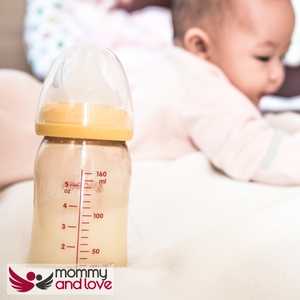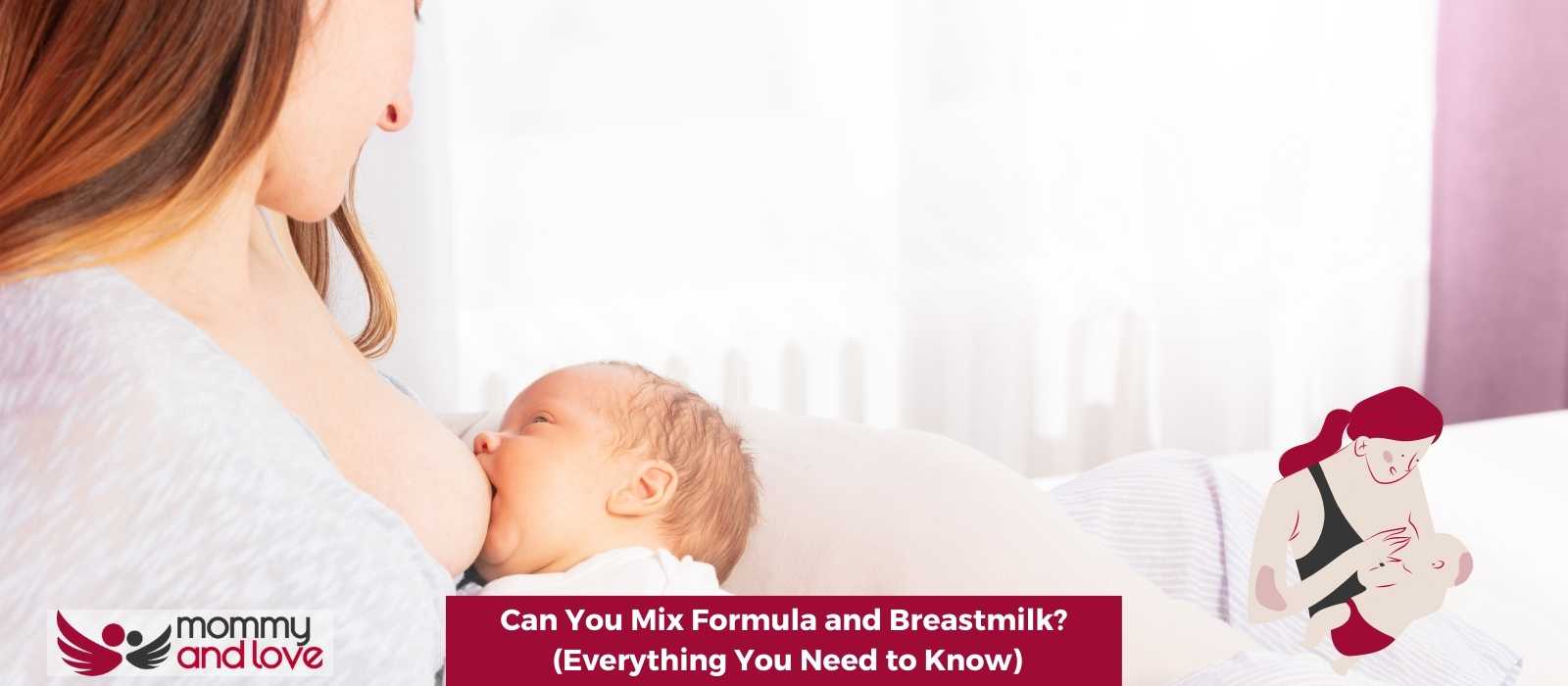When it comes to infants and their nutrition, there are a lot of decisions that parents have to make. One of the most important is whether to formula feed or breastfeed. For many mothers, breastfeeding is the best option. But for some mothers, breastfeeding isn’t possible or comfortable. In these cases, formula feeding can be a great alternative. But can you mix formula and breastmilk?
So, can you mix breastfeeding and formula feeding? The answer is yes – but it’s important to do so in a way that supports both baby’s health and mom’s milk supply. Formula can offer an option that meets nutritional needs while also allowing for breastfeeding parents to address and adapt to their own needs. It can also provide a sense of relief for mothers who are struggling with breastfeeding.
Can you mix breastfeeding and formula feeding?

Yes, you can mix formula and breastmilk. In fact, many parents do this for a variety of reasons from low milk supply to returning to work.
Some breastfeeding is better than none, so find a middle ground that works for you and your family.
For these parents, the question of whether they can mix breastfeeding and formula feeding arises. Formula can offer an option that meets nutritional needs while also allowing for breastfeeding parents to address and adapt to their own needs. It can also provide a sense of relief for mothers who are struggling with breastfeeding.
Combination feeding might be down to a one-off, like if you are not well or have food poisoning whilst you are breastfeeding, or might be down to a planned change of feeding type.
How to feed a combination of breast milk and formula?
There are two ways to do this, to do combination feeding or mixing powdered formula and breast milk in a bottle for the breastfed baby. Either works well and which you do depends on your own circumstances.
Combination feeding is when you offer either breast milk only feeds or some infant formula only feeds. Combination feeding is a great way to combine the benefits of breastfeeding with those from the formula. The milk provides your baby with nutrients they may be missing out on when exclusively breast-feeding, but it also gives you peace in knowing that if things get too difficult for either one or both parents then there’s an alternative!
Mixed feeds are when you offer bottle feeding combining formula and breast milk in the same bottle for baby’s diet. So you actually mix breastmilk and formula feeds together for mixed bottle feeding.
It is important to note that babies react very differently to breast milk and formula milk. Breast milk is very easily digested by their immature digestive tract whilst formula is harder for their stomachs to digest so they often take less than breast milk. This is not because it ‘fills’ them up more, but because their stomachs find it harder to process.
When to Try Combination Feeding?

If you have a low milk supply, you’re a mom of twins or even triplets or you’re heading back to work then combination feeding might help you adjust.
This is when you give both breast milk and infant formula to the baby, but don’t mix them in the same bottle together (this is mixed feeding).
Whilst exclusive breastfeeding is best for babies, the next best thing is to mix breastmilk as it is liquid gold. Whether it’s for one bottle or the first few bottles, even putting a little milk from mama in the bottle feed is better than none for the growing baby. Speak to your baby’s pediatrician or a board-certified lactation consultant if you feel you don’t have enough milk and want to try combination feeding.
If a baby has been exclusively breastfed then you need to properly prepare them to accept bottles or mixed bottle feeding. If a bottle has never been in a baby’s mouth then getting them to accept formula takes time. Baby breastmilk tastes and is absorbed very differently to formula by a young baby’s body, so they may initially reject any formula if they have been exclusively breastfed.
Low Milk Supply
If you are suffering from a low milk supply then seek the aid of a lactation consultant before trying combination feeding. This may actually make the situation worse for you as your body thinks that your baby needs less and produces less. If you are trying to increase your milk supply then stay hydrated, eat some lactation boosting foods and continue to feed or pump as often as you can.
In this situation an ideal combination feeding is to nurse first, on both sides, and when the baby has finished to ‘top them up’ with a formula bottle. Never give the formula bottle first.
You’re a Mom of Twins or Triplets
If you are a mom of multiples then you will know that breastfeeding can be tricky, especially if one or both babies are not gaining weight as they should. Formula feeding can help to ensure that all of your babies get the nutrients they need.
Feeding twins or triplets is hard so combination feeding might be ideal to help you all get into a routine (whether it’s twin A on formula in the morning and breast in the evening or whatever).
You’re Heading Back to Work
If you are heading back to work and want to continue breastfeeding then combination feeding can be a great way to do this. It allows you to express milk during the day and have it fed to your baby at night. This means that they still get the benefits of breast milk and you don’t have to stop breastfeeding altogether.
If you don’t want to spend your days at work pumping, we understand and in this instance, formula can be given. However, it’s wise to gradually introduce this change and gradually drop the amount of milk you are producing.
Mix Formula and Breast Milk in a Bottle
If you want to mix breast milk and formula in a bottle then you can do this too. This is a great way to introduce your baby to formula if they are having trouble with breastfeeding or if you just want them to have a bit of both.
When to Mix Formula and Breast Milk in a Bottle?
If you are supplementing breastfeeding with formula then mix breast milk and formula in a bottle. This will help your baby to get used to the taste of formula and they will be more likely to continue taking it.
It’s vital if you are doing that to follow a few steps:
- Mix the formula first before you add the breast milk. Once the formula is made, then you can add in your breast milk.
- Don’t use the breast milk as the water in the formula mix, mix it with water as normal. You always need to follow the ratio guidelines on the formula mix.
- If you are using the ready-made formula you can just mix the breast milk in.
- The higher the ratio of breast milk the more like the baby is to receive it
- If you have mixed breast milk in formula remember to keep it refrigerated and use it within 24 hours of making.
How Much Formula to Add?
If you are mixing formula milk and breast milk in one bottle then there is a different routine between mixing powdered or concentrated formula and liquid formula.
For a baby who has been exclusively breastfed start with mostly breastmilk and work your formula about up.
If you are trying to produce milk supply increase then do the opposite!
Powdered Formula or Concentrated Liquid Formula
These are both formulas that need water to be mixed before giving to the baby. It’s very important to make or mix these formulas first before combining them with human milk. Mixing breast milk should only be done after you have made up the formula.
Here are a few tips for feeding a combination of breast milk and formula:
-Mix formula with expressed breast milk in a bottle to create a custom blend that is more like breast milk.
-If you are using store-bought formula, try a brand that is closer to breast milk in terms of its composition.
-If you are using pumped milk, make sure to use it within 24 hours or freeze it.
No matter what feeding method you choose, always consult with your paediatrician to ensure that your baby is getting the right nutrition.
What if Baby Refuses a Bottle?
There are a few things you can do if your baby refuses to take a bottle:
-Try different nipples – some babies prefer a certain type of nipple over another.
-If your baby is used to breastfeeding, they might not like the feel of a bottle. Try warming up the milk or formula before giving it to them.-If your baby is older, you could try a sippy cup.
-Make sure that the bottle is clean and free of any residue. Burp your baby frequently while they are drinking from the bottle.
-Try to keep bottles and breast feeding sessions consistent. If you always feed your baby in one place, they will be more likely to accept a bottle there.
-Get someone else to give your baby a bottle – sometimes it can be easier for someone else to get them to take a bottle.
Keep Your Milk Supply While Giving Formula
If you are giving your baby formula, you might be worried about losing your milk supply. However, there are a few things you can do to help keep it up:
-Pump breast milk during the day, even if you are not going to be feeding it to your baby.
-Use a breast pump or hand express after feedings to help remove more milk.
-Drink plenty of water and eat healthy foods to help keep your milk production up.
-Try a lactation supplement like Fenugreek or Mother’s Milk Tea to help increase your milk supply.
The Bottom Line on Mixing Formula With Breast Milk
It is perfectly safe and fine to mix breast milk and formula, whether you do it with separate feedings or combined in one bottle. Whether its a once off so you get extra sleep or because you don’t want to be exclusively pumping when you go back to work, don’t panic! Warm milk is always loved by babies and whilst they might initially reject a formula bottle, once you follow the safety guidelines about mixing and trying a tips and tricks, everything should settle in.
When you are ready to feed your baby, you do what works for you and your family!

This article was written by Sandra Baker – full time writer and the mother of four amazing kids (including twins!)
She’s also a breastfeeding counselor and has spent years helping new parents learn how to care for their children. When she’s not writing or caring for her children, Sandra likes to spend time reading and taking walks with her husband.




